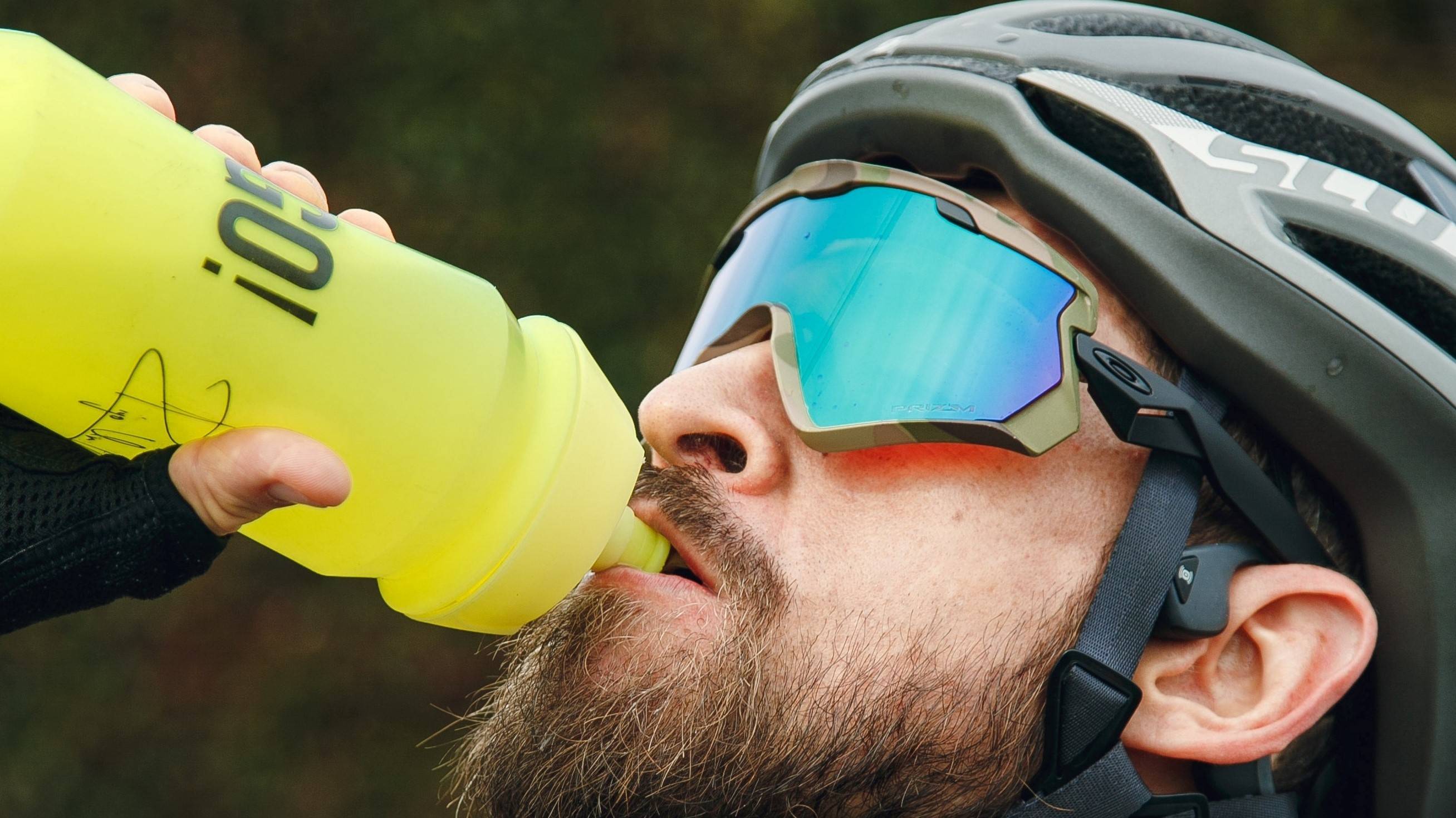Nicht wenige Sportler plagen sich im Wettkampf mit Magenproblemen. Häufige Ursache: Unverträglichkeit der Wettkampfernährung. Manchmal hilft dann eine genaue Analyse der Verträglichkeiten und ein Abstimmen der Ernährung. So haben selbst gemischte Sportgetränke gleich mehrere Vorteile: sie sind individuell abgestimmt und kostengünstig.
Nur wenige Inhaltsstoffe notwendig
In unserem Grundlagenartikel zum Thema Sportgetränke haben wir die drei Hauptaufgaben von Sportgetränken bereits ausführlich beschrieben. Daraus lässt sich schließen, dass im Grunde nur wenige Inhaltsstoffe für ein optimales Sportgetränk notwendig sind:
- Wasserverlust ausgleichen: Leitungs- oder Mineralwasser (ohne Kohlensäure)
- Elektrolyte ersetzen: Natrium (enthalten in Kochsalz oder Natron)
- Energiespeicher füllen: kurz- und langkettige Kohlenhydrate (Maltodextrin und Glukose)
Wasser und Kochsalz hat jeder zu Hause. Eine Alternative zum Kochsalz ist das Natron (Natriumhydrogencarbonat). 1 Gramm Natron enthält ca. 300mg Natrium und hat den Vorteil, dass es nicht so salzig schmeckt und zusätzlich als Säurepuffer (Laktatpuffer) im Körper dienen kann.
Effektiv: Maltodextrin
Maltodextrin ist ein Kohlenhydrat, dass den Energieersatz besonders effektiv gewährleisten kann. Maltodextrine sind Mono-, Di-, Oligo- und Polymeren der Glukose (Traubenzucker). Maltodextrin gibt es in unterschiedlichen Zusammensetzungen, die mit einem Süßungsgrad (DE) zwischen 3 und 20 bezeichnet werden. Zum Vergleich: Der Süßungsgrad von Stärke wird mit DE 1 und der von Glukose mit DE 100 angegeben. Gängige Zusammensetzungen von Maltodextrin sind DE6, DE12 und DE18/19. Ein höherer Süßungsgrad bedeutet einen höheren Anteil an schnell verfügbaren Mono- und Di-Kohlenhydraten. Aufgrund der zahlreichen Vorteile setzen auch die meisten Hersteller in ihren Sportgetränken Maltodextrin als Energieträger ein.
Vorteile von Maltodextrin:
- geringere Osmolarität als Glukose bei gleichem Energiegehalt
- gute Verträglichkeit
- langsamere Resorption führt zu geringem Blutzucker- und Insulinanstieg
- trotzdem effektive und schnelle Aufnahme im Dünndarm
- geschmacksneutral und wenig süß
Maltodextrine enthalten je nach Zusammensetzung bis zu 10% kurzkettige Kohlenhydrate, um den Anteil für besonders kurze und intensive Belastungen (z.B. Sprintdistanz) weiter erhöhen zu können benötigt man noch reine Glukose (Traubenzucker).
Es gibt so viele Produkte auf dem Markt, warum soll ich mein Sportgetränk überhaupt selbst mischen?
- Wer selbst mischt, weiß exakt was er trinkt.
Die meisten Sportgetränke im Handel enthalten neben den entscheidenden Substanzen (Wasser, Natrium und Kohlenhydrate) auch zahlreiche weitere Substanzen wie Mineralien, Vitamine, Süßstoffe, Aminosäuren und Geschmacksaromen in unüberschaubaren Mengen und Zusammensetzungen. Der Nutzen und die individuelle Verträglichkeit, insbesondere unter hoher körperlicher Belastung, zahlreicher dieser Stoffe ist kaum erforscht. Dies könnte auch ein Grund für die weitverbreiteten Magen- und Darmprobleme im Triathlon sein. Wer selbst mischt, reduziert die Inhalte seines Sportgetränks auf die entscheidenden Substanzen und kann somit genau überwachen, was er verträgt und was nicht bzw. welche Substanzen die eigene Leistungsfähigkeit optimal unterstützen. - Die Energiezufuhr kann exakt dosiert und angepasst werden.
Der Energiegehalt selbst gemischter Sportgetränke kann mit geringem Aufwand an die jeweiligen Wettkampfanforderungen angepasst werden. Es ist offensichtlich, dass die unterschiedlichen Streckenlängen im Triathlon auch unterschiedliche Anforderungen an die Zufuhr an Energie. In einer Sprintdistanz muss die zugeführte Energie beispielsweise sehr schnell zur Verfügung stehen, während in einer Langdistanz eine langsame und kontinuierliche Energiebereitstellung entscheidend ist. Mit einem selbst gemischten Sportgetränk kann sich jeder seine individuelle Zusammensetzung herstellen und ständig optimieren. - Selbst mischen schont den Geldbeutel.
Maltodextrin und Glukose (Traubenzucker) gibt es in der Apotheke oder über das Internet zu kaufen. Maltodextrin kostet nur knapp 10 Euro pro 1000g. Bei größeren Abnahmemengen sogar noch weniger. Im Vergleich zu den auf dem Markt erhältlichen Sportgetränken ist ein selbst gemischtes Sportgetränk also deutlich günstiger und erfüllt dabei mindestens die gleichen Funktionen.
Wie mische ich mein Sportgetränk selbst?
Das Selbstmischen lässt natürlich eine Vielzahl von Möglichkeiten offen, denn die Wettkampfverpflegung ist eine sehr individuelle Sache. Die Basis für das optimale Mischungsverhältnis stellen allerdings die wissenschaftlichen Grundlagen aus unserem Einstiegsartikel dar. Die Übersicht unten fasst die Optimalbereiche nochmals zusammen.
Optimalbereiche für das Mischen eines Sportgetränks:
- Der Kohlenhydrat-Gehalt sollte sich zwischen 4 bis maximal 10% bewegen (also 40-100g pro Liter), um gleichzeitig eine optimale Wasseraufnahme zu ermöglichen
- Die Osmolarität des Getränks sollte kleiner als 270-290 mosmol pro Liter sein (hypotones bis maximal isotones Getränk)
- Der optimale Natriumgehalt liegt zwischen 400 und 800mg pro Liter Wasser





















1 Kommentar
Tina Jung
Ich kann von Natron nur abraten. Das hat bei mir einen schmerzhaften Blähbauch verursacht.